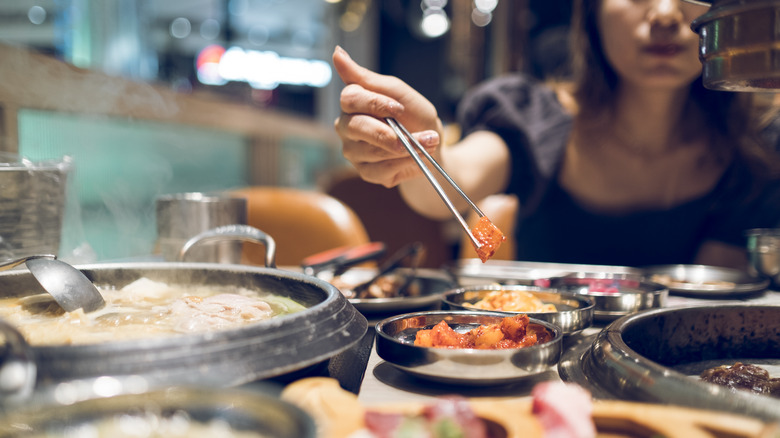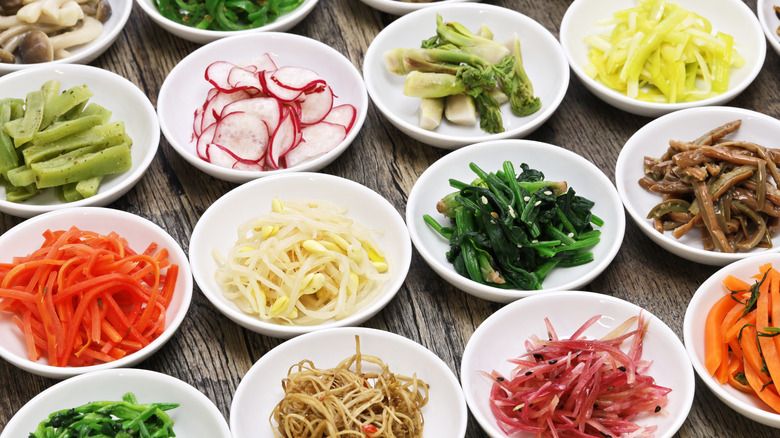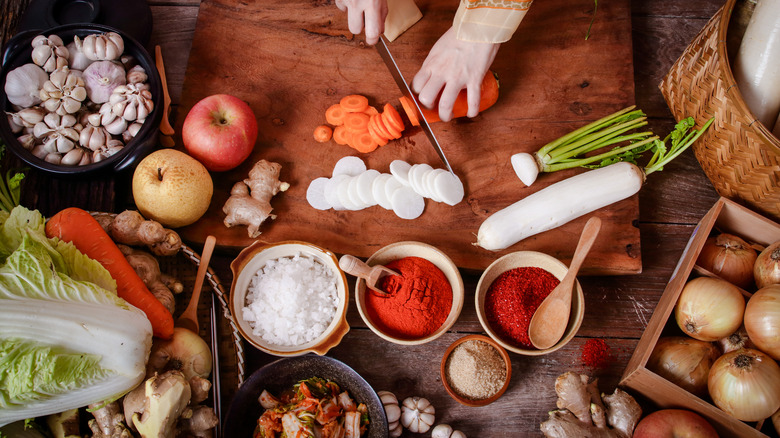The Korean Barbecue Etiquette You Need For Banchan
In the last twenty years, Korean culture has become increasingly popular around the world. K-dramas consistently rank in the top 10 Netflix programs worldwide, K-pop sensations like BTS perform on Saturday Night Live, and — most deliciously — Korean barbeque has become an accessible dinner option in cities around the country. But for those of us who are eager to try this interactive and delicious cuisine but aren't yet familiar with Korea's culinary culture, it could bring up some questions about how to enjoy this meal without inadvertently committing a faux pas.
Fear not — while Korean barbecue may feel like a whole new world, it's an informal, communal dining experience — though there is still crucial etiquette to know while dining on Korean food. The CliffsNotes on how to navigate a Korean banchan spread as respectfully as possible? Always let your elders eat first as a sign of respect, share dishes with your family and friends, and avoid over-ordering to prevent waste. Lastly, while sampling banchan before your order arrives is welcome, don't load up on them — you'll be pairing them with your chosen protein, rice, vegetables, and sauces throughout the meal. Beyond these rules, you're encouraged to choose your own adventure — though there's plenty of cultural context and advice to learn about banchan to elevate your appreciation and enjoyment of these delectable dishes.
Banchan best practices
Soon after you sit down at a Korean barbeque restaurant, you'll receive several small portions of banchan. The types of banchan you receive will vary from one restaurant to another, but fermented vegetables (kimchi) and lightly seasoned fresh or cooked vegetables (namul) are two categories you can expect to see. At this point, you may ask yourself: When am I supposed to eat them?
While it's perfectly acceptable to snack on banchan before receiving your protein or other dishes ordered, it isn't the Korean equivalent of free chips and salsa at a Mexican restaurant. They're traditionally paired with rice, meat, or vegetables and topped with a sauce like Ssamjang, soy sauce, or sesame oil. Some people choose to go through the meal building one perfect bite after another on a spoon, while others make Ssam (wraps), folding their chosen ingredients up in rice paper, dried seaweed, or lettuce leaves and eating them in one bite. Korean barbeque is a great chance to get creative, explore flavor pairings, and learn what you like. And if you finish your banchan, ordering additional servings is welcome. Just don't order more servings than you'll be able to finish to avoid food waste.
Banchan's cultural context
In English, we translate banchan as "side dishes" and tend to think of them as appetizers, but that's not what they are, and this misinterpretation highlights a key difference between American and Korean culinary culture. The origins of banchan reach back to the Three Kingdoms Era (sometime between 57 B.C. to 668 A.D.). Heavily influenced by Buddhist ideology, vegetarian dishes became the primary focus of the Korean diet. Since 80 percent of the land in Korea is not suitable for farming, and the country experiences harsh winters, preservation methods such as drying, pickling, and fermenting became essential to sustaining the population. Pairing banchan of fresh, preserved, or fermented vegetables, with rice, soup, or stews — whatever was accessible in a given place or season — became the traditional spread.
Even once meat became more common in the Korean diet, this way of eating persisted. Korean cuisine holds rice as the heart of a dish, and banchan are incorporated to build flavor, texture, and elevate the overall experience of the meal. With this history in mind, we can see how the label "side dish" fails to encapsulate what banchan really is.



